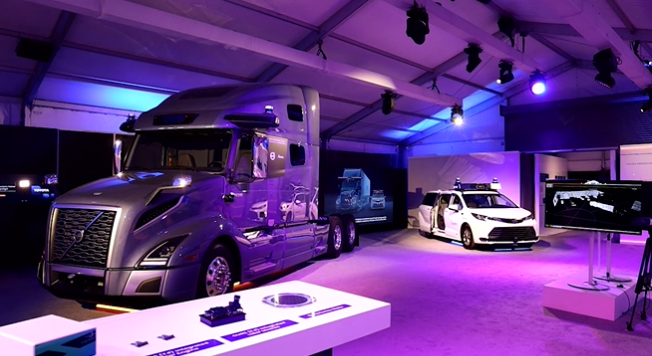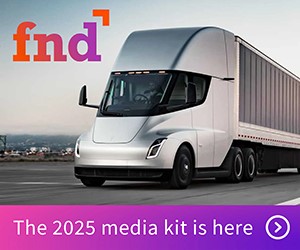Aurora Autonomous demonstrates the Aurora Driver at its first-ever Investor and Analyst Days
At Aurora Illuminated, company showcases its progress, technical expertise, and path to commercialization
Self-driving company Aurora hosted Aurora Illuminated, an immersive experience for investors and analysts, showcasing the company’s progress, technical expertise, and path to commercialization. Held at the company’s South Dallas Terminal in Palmer, Texas, attendees saw how the Aurora Driver operates in the real world as they rode autonomously along Interstate 45, a major freight corridor, in Aurora’s autonomous trucks. (You can experience Aurora Illuminated here and view event videos and photos here.)
“This is an exciting time for Aurora. Through close collaboration with our partners, we are delivering on key milestones on our path to market in both trucking and ride-hailing,” said Aurora co-founder and CEO, Chris Urmson. “This week in Texas, attendees experienced the Aurora Driver first-hand with rides in our autonomous trucks – a culmination of our company’s technology, partnerships, and focus on safety.”
Earlier this summer, Aurora announced its plan to merge with the special purpose acquisition company (SPAC) Reinvent Technology Partners Y (NASDAQ: RTPY). The company expects to be listed on Nasdaq with the ticker symbol AUR before the end of the year.
“We continue to be impressed with Aurora’s team and the progress they’re making with both their cutting-edge technology and their path to market,” said Michael Thompson, co-founder and CEO of Reinvent Technology Partners Y (RTPY). “Aurora Illuminated was an exciting showcase of how all of Aurora’s strengths come together to deliver the Aurora Driver and what we expect to be a scalable business.”
In addition to investors and analysts, the company invited automotive partners, customers, government officials, and its Safety Advisory Board to Aurora Illuminated.
Aurora-powered trucks autonomously hauling goods on Texas highways
Guests rode in an autonomous Peterbilt 579 on a stretch of Interstate 45, driven by more than 8,500 conventional trucks a day. The route included onramps, offramps, and the surface roads leading up the entrance of the interstate. The route allowed the Aurora Driver to show how it routinely navigates construction, emergency vehicles, and even the occasional pedestrian walking a dog on a road adjacent to the interstate. The route is driven autonomously with safety drivers present.
The autonomous Peterbilt 579 is tightly integrated with the Aurora Driver, which includes Aurora’s purpose-built hardware kit, designed for performance, reliability, and scale. Deeply integrated with Aurora’s software, Aurora’s industry-leading FirstLight Lidar, high-resolution cameras, and imaging radar can see further, process data quickly, and respond with high accuracy for safe driving in varying conditions and speeds.
Prior to Aurora Illuminated, the company had already driven more than 4.5 million on-road miles, as well as billions of effective miles in Aurora’s Virtual Testing Suite.
Marrying rigorous engineering with advanced machine learning, Aurora showcases how its innovative software and hardware power the Aurora Driver
“Aurora’s approach to developing a self-driving product is one that is designed to be both safe and scalable—an approach that’s driven by data, harnesses the power of machine learning and artificial intelligence, and leverages the strengths of a world-class team of software and hardware engineers,” said Aurora co-founder and Chief Scientist, Drew Bagnell.
The company highlighted key innovations including:
- Advancing the Aurora Driver through valuable data that drives Machine Learning & AI: Aurora has built important key foundational tools that enable fast interactions and rapid innovation and advancement to power the Aurora “Data Engine” as it collects, mines, labels, and feeds into models training on-road data. This fast iteration cycle provides the teams with the information they need to rapidly advance the capabilities of the Aurora Driver.
- Designing purpose-built hardware for performance, reliability, and scale: Whether it’s Aurora’s powerful computer or advanced FirstLight lidar sensors, the company’s tightly integrated hardware and software teams jointly design high-performance, custom-built hardware that meet the specific needs of the Aurora Driver.
- The power of Aurora’s perception system: Leveraging deep learning & early sensor fusion to see the world in full 3D and at long ranges: Aurora’s state-of-the-art perception system provides the Aurora Driver with advanced situational awareness, made possible through its innovative approach to the integration of deep learning and probabilistic state estimation.
- Aurora Atlas: Lightweight, scalable, high-definition maps for safe autonomous driving: Aurora is approaching HD mapping in a unique, innovative way that is built for rapid expansion through custom-built machine learning tools and automation.
- Aurora’s simulation engine: Accelerating development and validation through scalable simulation in virtual worlds: Simulation testing, which drives the development of the Aurora Driver, is the quickest and safest way to train and test our self-driving technology.
- Interactive forecasting and learned decision making: Using machine learning to make better driving decisions: Aurora’s learned, interleaved approach to forecasting and planning allows the Aurora Driver to reason about how other vehicles behave and make safe, predictable decisions on the road.
Aurora shows Volvo VNL truck and Toyota Sienna, both powered by the Aurora Driver
Aurora continues to make progress towards deploying an autonomous trucking business by late 2023 and ride-hailing in late 2024 through deep partnerships with truck manufacturers, PACCAR and Volvo Trucks, and automaker, Toyota.
The company displayed two different vehicle prototypes, progress it is making through the Aurora Driver Development Program, which will ultimately deliver vehicles that move goods and people autonomously through the world:
- The Volvo VNL truck, powered by the Aurora Driver, is the design prototype of Volvo’s first autonomous truck, intended for commercial production. On-road testing of the fully integrated VNL will begin in 2022.
- The Toyota Sienna, powered by the Aurora Driver, is the prototype of Toyota’s first “Sienna Autono-MaaS” intended for mass production. Aurora is currently integrating its Driver into the vehicle and will have a testing fleet of about a dozen vehicles out for testing and validation in Pittsburgh, the San Francisco Bay Area, and Texas.
Aurora’s industry-leading safety work is critical to deploying self-driving technology at scale
Safety plays a key role in everything Aurora does, from how it tests and develops its technology to how it plans to deploy the Aurora Driver at scale. During the event, the company highlighted its industry-leading work, including its Safety Management System and transparent and collaborative approach to working with private and public partners. It also featured an interactive demo of its Safety Case Framework, an imperative component for any company looking to operate without a safety driver and safely deliver commercial-ready self-driving vehicles at scale. Aurora is the only company to share a framework that addresses both autonomous trucking and passenger mobility.
Over the next few weeks and months, Aurora will continue to share more about its work as the company deploys its technology safely, quickly, and broadly.
Category: AUTONOMOUS, Cab, Trailer & Body, Connected Fleet News, Driver Stuff, Electric Vehicles, Equipment, Featured, Fleet Tracking, General Update, Green, Management, News, Products, Safety, Tech Talk, Vehicles











